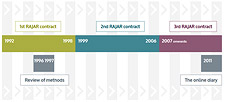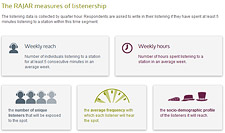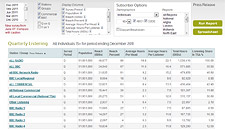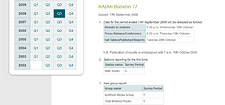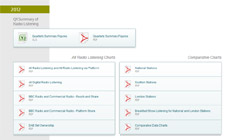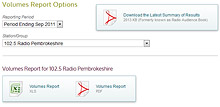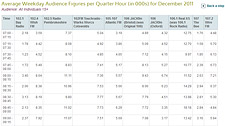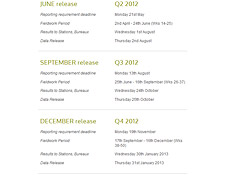How the survey is conducted
The RAJAR sample
- The universe comprises all individuals aged 10 and over, living in private households in the UK.
- Although children from the age of 10 are included in the survey, published figures are for Adults 15+, unless stated otherwise. Data on respondents under 15 can only be accessed by RAJAR subscribers.
- So that small stations can be surveyed, the overall diary sample is about 100,000 per year, with each respondent only participating for one week (a panel participant contributes up to 3 diaries per Quarter).
- The passive panel sample is 5000 individuals (RAJAR recontacts) whom are nationally representative by geography and demographics.
- The sampling is devised so that each station’s sample is representative of the area it covers. The smallest sample for a station on RAJAR is 500 diaries over 12 months, for stations with a TSA (Total Survey Area) under 300,000. The National stations report on a quarterly sample of approximately 25,000 diaries.
The RAJAR sampling procedure
- Stations have to define the area where they want to be surveyed by selecting a list of postcode districts.
- All station maps are overlaid, the resulting 550 non overlapping areas are called segments and constitute the sampling framework.
- Each segment is attributed a recruitment target for each quarter and sampling points are allocated accordingly.
- A sampling point is a list of addresses from which interviewers have to recruit. This list is drawn at random using the Postal Address File. Self selection of respondents (i.e. people who approach RAJAR and ask to participate in the survey) is not permitted.
The interviewing process
- Participants in the survey are asked to complete a listening diary for one week. They are not asked to complete the task retrospectively (i.e. for the week before placement) – instead they are asked to start recording their listening as it happens for the week ahead.
- Diary placement is continuous throughout 50 weeks of the year, excluding the Christmas and New Year holiday period.
- Generally speaking, only 1 respondent is recruited per household.
- Quotas are set to ensure the best possible demographic representation of the area.
The listenership questions
- Once an individual has agreed to take part, the interviewer asks a series of questions related to the respondent’s demographic details, household tenure, number of radio sets, access to digital platforms (TV, internet, DAB) etc…
- The respondent is then asked to keep a listening diary for one week, detailing for each quarter hour, which station they listened to, where, and on which platform. Only live listening is measured.
- The listening diary is recorded via online, paper or a mobile app.
- The interviewer conducts a procedure in which each respondent is asked to sort through a set of cards with the names of radio stations available in the area. This is then used to personalise the respondent’s diary.
- The diary also comprises a self completion questionnaire which covers media consumption including television viewing, newspaper readership, listening to podcasts and via mobile phone etc…
- At the end of the diary week, the interviewer comes back to the respondent’s home to pick up the diary.
The data processing and reporting
- The panel data is processed and combined with the diary data.
- All the diaries are scanned and the data is quality checked.
- The data is then weighted so that the representation of each demographic group is restored to its correct proportion in the area.
- Results for each station are published on their TSA every quarter, with a sample based on the latest 3, 6 or 12 months of data depending on the size of the station's TSA.


